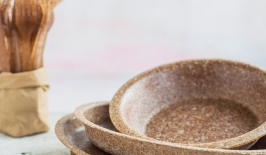A few weeks ago, the EU committees in Brussels finally agreed to a ban on plastics. Starting in 2021, it will see all items banned from the EU for which there are already cheap, plastic-free alternatives. As well as drinking straws and disposable plates, that also includes cotton buds and takeaway cups made of polystyrene. Certain disposable products that contain plastic – such as wet wipes – will also have to come with a compulsory label. And the requirements for packaging and drinks bottles are also to be tightened up.
At the same time, the EU Commission has already initiated another project to reduce the consumption of plastic water bottles – free access to drinking water fountains and the right to cheap tap water in restaurant – designed to incentivise and make it easier for people to drink water from the tap instead of from plastic bottles.
Manufacturers are to shoulder some of the responsibility too: in the future, companies that produce fast-food packaging, thin plastic bags and cigarette filters will have to contribute to the costs of waste disposal and help finance environmental education campaigns. This means that the cigarette industry, for example, will have to contribute to the costs of cleaning cigarette butts from beaches and parks.
And manufacturers will also have to also ensure that 90 per cent of all plastics are collected and recycled separately by 2025. According to the EU Commission, currently only a third of all plastic waste is collected and recycled. Most of the rest ends up lying in rubbish dumps or in our forests and oceans.
The aim of these EU measures is to reverse the trend in plastic consumption, and most of all, to stop more plastic waste flowing into our seas. As banal as the banned list may sound, according to official EU figures, it is designed to ban exactly those everyday plastic items that make up more than 70 percent of the plastic waste floating in the oceans. After all, the annual straw consumption of an EU citizen, is estimated to be around 71 straws on average. If you add that all up for every citizen in the EU, that’s a pretty significantly sized mountain of plastic.
So can we expect that over the next three years cotton buds and disposable plastic tableware will gradually disappear from the shelves of all supermarkets across Europe, and that alternatives made of paper, cardboard, wood, fruit and vegetable waste will appear instead?
That certainly sounds pretty promising. And there does already seem to be movement in that direction. The first fast-food chains are already experimenting with plastic-free alternatives and supermarkets are following suit.
But: the EU’s decision doesn’t mean the plastics ban debate is over. The EU member states still have to transpose the directive into national law by 2021. And while the ban on straws and the like has already been decided on, other measures such as deposit schemes, are still “in the pipeline”. What’s more, unfortunately, is that in the past, we’ve often seen very concrete resolutions ending up being translated into incredibly watered-down legislation. Last but not least, of course, is the question of how much impact these requirements really can have. Are they far-reaching enough?
Plastic Straws and Cups? Is This the Best We Can Do?
Let’s face it, we’re surrounded by plastic. A quick look around me: under my fingers there’s a laptop, next to it a smartphone, ballpoint pen, cables and chargers. When I look up: the desk lamp, chairs, even more cables, sockets. All of these things are mostly made of plastic. And what about you? If you look around, how much plastic is around you?
Plastic is a constant throughout our whole lives. Have you ever tried to go shopping in an average supermarket without picking up plastic in any way? Your shopping basket wouldn’t get very full. And looking for practical and affordable plastic-free alternatives can take hours of research. Living plastic-free, in today’s world, is a Herculean task. And sure, in many places plastic is irreplaceable. Therefore, what we need is not a loose collection of measures, but a master plan. A master plan that clearly defines where plastic can easily be got rid of, what a genuine circular economy and clever deposit schemes look like, and that takes a closer look at recycling and derives smart regulations from it.
Heike Vesper, marine conservation expert at WWF Germany, says: “It’s important to tackle disposable plastics directly, but with disposable plastic products from the food industry, the EU is only targeting the tip of the iceberg.”
But the EU’s ban on plastics doesn’t have to be talked down to the smallest detail. Because this step clearly shows that a trend reversal is taking place in our inconsiderate plastic consumption. Now it’s time to pick up speed and go even further.
And finally, we have to bite the bullet and accept the truth: it all comes down to our consumer behaviour. Because too much is too much, regardless of whether it’s plastic, wood or whatever resource.
At RESET, we’ve been taking a close look at plastics for a long time, whether it’s the plastic soup in our oceans, the microplastics in the air we breathe, or when we’ve been reporting on plastic-free alternatives. Click here for the ultimate list of everything we’ve ever written on the topic.
This is a translation by Marisa Pettit of an original article which first appeared on RESET’s German-language site.








